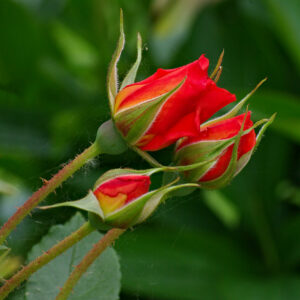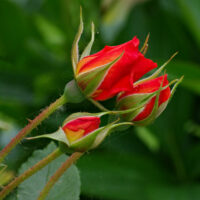
A letter from Jim in Minnesota
Caring for your flower garden is a year-round job, especially if you’ve got roses! Here’s a letter from a keen gardener in MN who wanted to share some tips and techniques – and a secret recipe.
My wife and I have been looking into landscaping our back yard, and have discovered that landscape companies and professional gardeners don’t come cheap…and they are often quite busy! We had an idea of growing rose beds in the back yard, and weren’t sure if we could do it ourselves, but it turns out that there are inexpensive ways of growing roses large and beautiful, just like the “Lawn Doctor.”
First, you must choose a sunny spot, as roses that are denied sunlight wither and get fungal diseases. If sunlight is iffy in your back yard, there are various ways of helping your roses to find it. Many nurseries sell large tubs on wheels that one can drag around a yard with a rope, chasing the wandering sun, and then setting your roses where they can thrive.
However, when you decide to plant in the ground, and have found a sunny area that is well drained (to avoid drowning the roots in your plant) spade a deep hole, about two feet wide and two feet deep. This will give your rose roots lots of space, and they will “feed” better. Fill the hole with a concoction of:
1. 1/3 dirt from the hole
2. 1/3 peat moss, available at any nursery
3. 1/3 compost
Fill the hole with enough of this mixture so that the soil in the container of the bush you’ve purchased will sit level with the surrounding area. Set the bush in the container in the hole, and add or remove soil as needed.
Secret sauce:
To add a little “zing” to your plant, there is yet another concoction.
1. A table spoon of fish fertilizer or emulsion, available at the nursery
2. A tbsp of corn syrup
3. A gallon of water
Mix this up and spray the bush with it, soaking the roots.
Squeeze the container to loosen and release your plant and place one hand over the surface and turn the plant upside down catching the bush as it slides from the container, but take care NOT to catch it by the fragile stem.
Place the plant in the hole, filling the area around it with the remaining soil mixture, patting the soil down and watering it a bit. Remember to concentrate the watering on the plant base, as it keeps the foliage dry.
Lightly water the rose plant three times a week for a month or so, and then give it a heavier soaking twice a week. Adding mulch to the rose bed helps moisturize the topsoil, and keeps it cool in the summer. Weeds find it difficult to grow through mulch, so that problem is also eliminated.
It is ridiculous to purchase over-priced mulch in those heavy plastic bags, breaking your back to haul them home from the nursery. Mulch is easily created from shredded bark, compost and various other detritus such as leaves or grass clippings.
Buy instant fertilizers, but do not use it in excess, as too much inorganic fertilizer can destroy roots and foliage. Free and quite effective fertilizer can be made from the garbage can: rotten bananas have potassium, old tea bags add valuable acids to help roses thrive, and parsley planted around the bushes increases the sweet rose smell.
Maintaining a healthy rose bush or bed is crucial. Remove dead growth and old canes, and prune branches that go toward the center of the bush for better ventilation for your roses.
Sometimes there will be ugly black spots on the rose petals. Although many experts recommend just cutting these petals away, there are safe, non-pesticide sprays that can help.
Mix:
1 tbsp of baking soda
1 tbsp of vegetable oil
1 tbsp of liquid soap
1 gallon of water
Put this in a large plastic spray bottle (empty bottles are sold at nurseries) and spray the damaged blossoms about once a week.
If you wish to let your roses develop hips in the autumn, don’t do any pruning after the last bloom at summer’s end.
When winter comes, your beds must be protected. Stop cutting roses off the bushes two months before the snow and ice arrive. At some point the roses will withdraw, a process called becoming “dormant.”
As this happens, cut down on watering the plants, and clean up any stray rose petals and branches that have dropped, a natural process during fall. This is the time to clean up old mulch, as it is a shelter for harmful insects. After the ground freezes in early winter, re-mulch your roses. The frozen ground will prevent the mulch from becoming a hotel for moles and gophers.
One last tip, the “Minnesota Tip” This involves trenching the rose plant in the ground by loosening half the roots and laying the plant into the trench. Then cover the plant with straw and soil.
